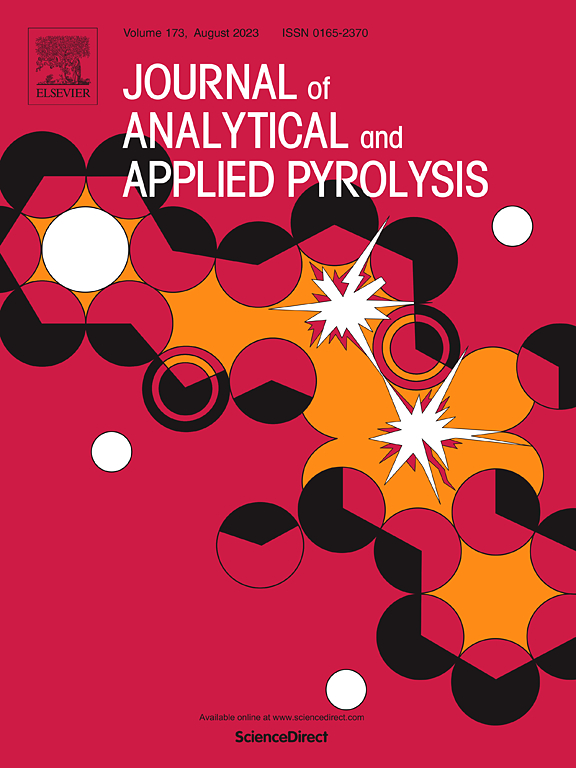Mapping of tobacco conversion characteristics in electrically heated systems: Effect of air and temperatures on the onset of combustion and formation of volatile species
IF 5.8
2区 化学
Q1 CHEMISTRY, ANALYTICAL
引用次数: 0
Abstract
The understanding of tobacco pyrolysis and oxidation mechanisms is an important topic for tobacco science in order to reduce the emissions of toxic species and to better control the conversion of tobacco in electrically heated tobacco products (EHTPs) by avoiding combustion. In this work, we have instrumented experimental Tobacco Heating Devices (expTHD) with a micro-positioning system of a thin thermocouple. Each expTHD has a pre-programmed set temperature (between 250 and 550°C) to be able to investigate the influence of temperature on tobacco conversion characteristics and emissions. Puffing cycles were conducted under air or N2 in order to understand the effect of oxygen on tobacco conversion and the resulting emissions. Electrically Heated Tobacco Products (EHTPs) were heated by the expTHD to the different final set temperatures, and puffs were drawn according to the specified puffing cycles. The conversion of tobacco becomes clearly exothermic with air from 400°C after 8 puffs, indicating that combustion was triggered. Below a set temperature of 400°C, the tobacco conversion is always net endothermic, which includes the tobacco temperatures of commercially available Tobacco Heating Systems (THS) during operation (typically lower than 325°C). Furthermore, the volatiles emitted during the puffing cycles were sampled in cold impingers. PAHs (naphthalene, phenanthrene, pyrene, and benzo[a]pyrene) were quantified by HPLC-UV Fluorescence. Benzene and toluene were quantified by GC/MS. Gases (CO, CO2, CH4, H2) were quantified by FTIR and µGC. The mass yields of all these species are presented as a function of the final set temperature of the expTHD and of the carrier gas used during the puffs (air or N2). CO2 yields are higher for air than for N2 even at 250°C, highlighting some low temperature oxidation reactions, but they did not lead to a detectable exothermic regime. A jump in CO formation is observed from 400°C under air, indicating combustion of the tobacco. Benzene and PAHs are promoted by air (compared to N2) from 400°C (heater set temperature). Therefore, air does not promote the formation of these species during the operation of the commercially available THS.
绘制电加热系统中的烟草转化特征图:空气和温度对开始燃烧和形成挥发性物质的影响
了解烟草热解和氧化机制是烟草科学的一个重要课题,目的是减少有毒物质的排放,并通过避免燃烧更好地控制烟草在电加热烟草制品(EHTPs)中的转化。在这项工作中,我们利用薄热电偶微定位系统对实验烟草加热装置(expTHD)进行了检测。每个 expTHD 都有一个预先设定的温度(250 至 550°C),以便研究温度对烟草转化特性和排放的影响。为了了解氧气对烟草转化和由此产生的排放的影响,在空气或 N2 下进行了膨化循环。用 expTHD 将电加热烟草制品(EHTPs)加热到不同的最终设定温度,并按照指定的膨化周期进行抽吸。8 次抽吸后,烟草在 400°C 的温度下与空气的转化明显放热,表明燃烧已被触发。在设定温度 400°C 以下,烟草转化总是净放热,这包括市售烟草加热系统(THS)在运行期间的烟草温度(通常低于 325°C)。此外,抽吸过程中的挥发物是在冷撞击器中取样的。多环芳烃(萘、菲、芘和苯并[a]芘)通过高效液相色谱-紫外荧光法进行量化。苯和甲苯通过气相色谱/质谱仪进行定量。气体(CO、CO2、CH4、H2)通过傅立叶变换红外光谱和 µGC 进行定量。所有这些物质的质量产率与 expTHD 的最终设定温度和喷射过程中使用的载气(空气或 N2)有关。即使在 250°C 的温度下,空气中 CO2 的产率也高于 N2,这表明存在一些低温氧化反应,但这些反应并未导致可检测到的放热反应。在空气条件下,从 400°C 开始,CO 的生成量骤增,表明烟草发生了燃烧。从 400°C(加热器设定温度)开始,空气(与 N2 相比)会促进苯和 PAHs 的生成。因此,在市售 THS 的运行过程中,空气不会促进这些物质的形成。
本文章由计算机程序翻译,如有差异,请以英文原文为准。
求助全文
约1分钟内获得全文
求助全文
来源期刊
CiteScore
9.10
自引率
11.70%
发文量
340
审稿时长
44 days
期刊介绍:
The Journal of Analytical and Applied Pyrolysis (JAAP) is devoted to the publication of papers dealing with innovative applications of pyrolysis processes, the characterization of products related to pyrolysis reactions, and investigations of reaction mechanism. To be considered by JAAP, a manuscript should present significant progress in these topics. The novelty must be satisfactorily argued in the cover letter. A manuscript with a cover letter to the editor not addressing the novelty is likely to be rejected without review.

 求助内容:
求助内容: 应助结果提醒方式:
应助结果提醒方式:


